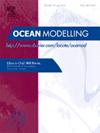On the speeding up and accuracy of the Second Order Moment (SOM) advection scheme using a mixed-precision method
IF 3.1
3区 地球科学
Q2 METEOROLOGY & ATMOSPHERIC SCIENCES
引用次数: 0
Abstract
The ocean model is accelerated using the mixed-precision method for the second-order moment (SOM) advection scheme, which is highly accurate but computationally demanding. The execution time of the subroutine of the SOM scheme is successfully reduced by 43%, and since the SOM accounted for about 30% of the total time, the overall reduction in computation time is about 13%. A series of 300-year simulations showed that the mixed-precision method has sufficiently small negative impact on temperature (less than 0.02 °C), confirming that it can be used for climate simulations. When all the calculations are done in a simple single precision, an unacceptable difference in zonal mean temperature as a climate model of up to 0.4 °C in the deep ocean and 1 °C in the thermocline appears after the 300-year integration. We also conduct a sensitivity study using an idealized rectangular model, finding that consistency between the continuity equation and the tracer advection is necessary to guarantee accuracy in long-term integration, and it is shown that this consistency can be checked in a short time in a small rectangular domain as an salinity anomaly. In addition to the mixed-precision method, we have introduced two other methods for calculating the single-precision SOM algorithm. One is the Kahan method to compensate for the loss of information in the addition of some important variables represented in single precision, and the other is the conversion reduction method to compensate for the error due to data conversion between single and double precision at the entry and exit of subroutines. When both the methods are used simultaneously, the accuracy is comparable to mixed precision. We also evaluate them in an eddying OGCM and find that errors are difficult to evaluate because they are hidden by the inherent nonlinearity of the model at the stage when the nonlinearity develops.
基于混合精度方法的二阶矩平流格式的加速和精度研究
采用二阶矩平流格式的混合精度方法对海洋模式进行加速,该方法精度高,但计算量大。SOM方案子程序的执行时间成功地减少了43%,由于SOM约占总时间的30%,因此总体计算时间减少了13%左右。300年的一系列模拟表明,混合精度方法对温度的负面影响足够小(小于0.02°C),证实了它可以用于气候模拟。当所有的计算都以简单的单一精度进行时,在300年的整合之后,作为气候模式的纬向平均温度出现了不可接受的差异,在深海中高达0.4°C,在温跃层中高达1°C。我们还使用理想矩形模型进行了灵敏度研究,发现连续性方程与示踪平流之间的一致性对于保证长期积分的准确性是必要的,并且表明这种一致性可以在短时间内以盐度异常的形式在小矩形域中得到检验。除了混合精度方法外,我们还介绍了另外两种计算单精度SOM算法的方法。一种是Kahan法,用于补偿单精度表示的一些重要变量的加入所造成的信息损失;另一种是转换约简法,用于补偿子程序入口和出口的单精度和双精度之间的数据转换所造成的误差。当两种方法同时使用时,其精度与混合精度相当。我们还在一个旋转OGCM中对它们进行了评估,发现在非线性发展的阶段,误差被模型固有的非线性所隐藏,因此很难评估。
本文章由计算机程序翻译,如有差异,请以英文原文为准。
求助全文
约1分钟内获得全文
求助全文
来源期刊

Ocean Modelling
地学-海洋学
CiteScore
5.50
自引率
9.40%
发文量
86
审稿时长
19.6 weeks
期刊介绍:
The main objective of Ocean Modelling is to provide rapid communication between those interested in ocean modelling, whether through direct observation, or through analytical, numerical or laboratory models, and including interactions between physical and biogeochemical or biological phenomena. Because of the intimate links between ocean and atmosphere, involvement of scientists interested in influences of either medium on the other is welcome. The journal has a wide scope and includes ocean-atmosphere interaction in various forms as well as pure ocean results. In addition to primary peer-reviewed papers, the journal provides review papers, preliminary communications, and discussions.
 求助内容:
求助内容: 应助结果提醒方式:
应助结果提醒方式:


